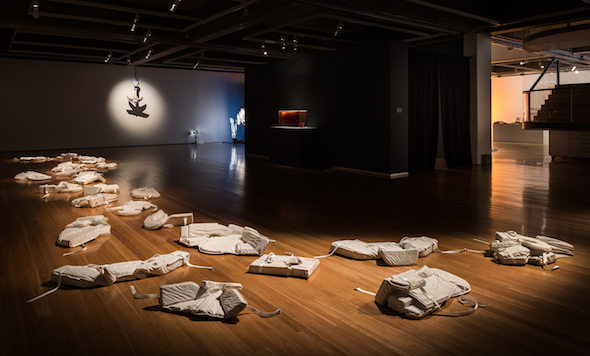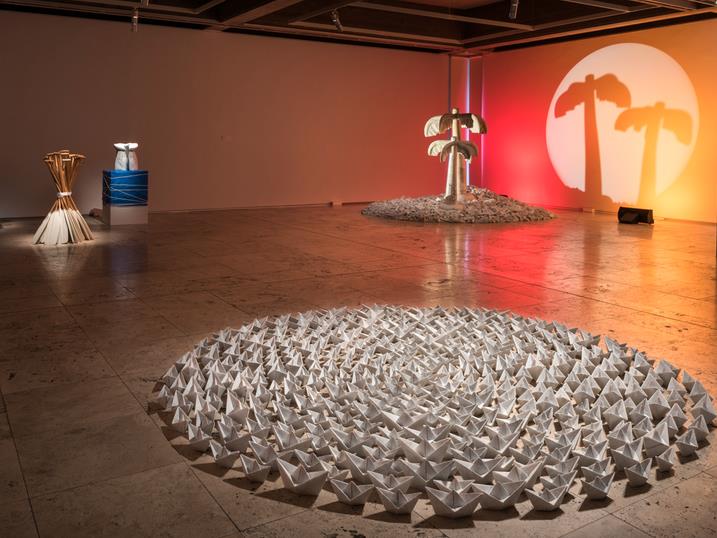Surface beauty and what lies beneath is a subject with endless possibilities for artists – as two new exhibitions and a major art prize illustrate.
Newcastle Art Gallery is currently showing solo exhibitions by Sydney artist Alex Seton and Brisbane-based Michael Zavros in an unlikely pairing with surprising parallels.
As bodies of work they are totally disparate stylistically. One is a suite of socially questioning marble sculptures that call on the medium’s heroic traditions to tell a less heroic story of the refugee crisis. The other is a survey of photo-real paintings that are so close to the glossy pages of magazines that they beg us to question our desires and subscription to the ‘body perfect’ treadmill.
But Seton and Zavros resonate. Both play with the veneers of beauty to probe at more layered conversations.
Sitting as a backdrop to these, is the invitation to all artists to find their own conversation with the human form. The Gallery has announced that it is accepting entries for the 2017 round of the annual Kilgour Prize.
Submissions must represent the figure or a human likeness and the work is to be executed as a painting, but is open to the interpretation of the painted media from oil to watercolour, acrylic and mixed media.
Applications open for the $50,000 KILGOUR PRIZE.

Alex Seton Oilstone 04_Saturated 2016 Bianco Carrara marble, engine oil, glass tank dimensions variable Artist collection Photography: Mark Pokorny
Body absent is a body present
Some people might struggle with the idea that a boat outboard motor submerged in luscious red engine oil has anything to do with the body – a view possibly confirmed when they learn that the engine has been finely sculpted from marble; a stone usually reserved for monumental sculptures.
Alex Seton’s Oilstone 04_Saturdated (2016) is not figurative but it is every bit as heroic as its sculptural forbearers. He told ArtsHub that he was motivated by ‘the idea of complicity’, that while Australian policy currently states mandatory detention, as a nation it is participating in the wars that have contributed to the current refugee crisis.
‘Very simply put, there is blood on our hands,’ he said. ‘I certainly subscribe to Nina Simone’s view that an artist has a duty to reflect the times that they live.’
The sculpture is presented among a suite of pieces from 2013 to the present, sculptural installations that hone in on the escalation of Australia’s refugee policy. Titled THE ISLAND, it sits in the gallery with a flotilla-like sensibility, dramatically lit.
Unlike Zarvos whose paintings dwell on the body, Seton uses objects to portray stories of a human nature. He told ArtsHub: ‘I choose objects because they cannot be ignored easily; they have a power of insistence’.
‘This is something happening in our day – in our lifetime – this is not something dreamt up.’

Installation view of ALEX SETON: THE ISLAND at Newcastle Art Gallery; Photography: Mark Pokorny
His installations provoke viewers to confront their own beliefs and morals when it comes to Australia’s immigration history and current policy. ‘It is inherently hypocritical of the Australian Government to be stopping the boats, describing it for ‘humanitarian purposes’, while the current situation could be defined as a kind of purgatory hell’, said Seton.
‘This truly shows us the power of great works of art,’ said Gallery Manager Lauretta Morton. ‘Marble is a material more commonly seen in commemorative statues of great statesmen – not unknown asylum seekers.
‘With these sculptures of life jackets, paper boats or inflatable palm trees – the literal heaviness of the materials is quietly poignant,’ she added.
Seton continued: ‘We have seen the issue slowly creep off the map in terms of the media and social media and a complacency within the Australia population from a “fatigue of the issue”’.
A mandala-like display of dozens of marble “paper boats” in the installation Paper Armada 2015 captures that endless cycle within which we are caught. While Someone died trying to have a life like mine 2013 was inspired by an actual event where 28 life jackets were found on a beach of the Cocos Islands within Australian territory. Seton reminds us the owners still remain unidentified.
THE ISLAND may have romantic illusion of tropics and paradise, but for Seton its contemporary tone is more sinister as a place of those deserted.

Michael Zavros The Mermaid (2015), Purchased 2015 Newcastle Art Gallery collection; courtesy the artist and Starkwhite
Body magic as painted magic
Previous Kilgour Prize Finalist, Michael Zavros, is known for his impeccable photo-real style. In MAGIC MIKE he fleshes out his ongoing interest in the ‘body beautiful’ and contemporary society’s obsession with self-perfection and vanity.
Zavros has long been interested in gym culture, and Newcastle has the highest concentration of gyms per capita of any Australian city.
Alongside his paintings, a temporary gymnasium has been installed within the exhibition and is activated through a series of live performances. Zavros says it draws on ‘an allusion between the repetitive act of working out and the act of painting’, both of which he suggest are romantic pursuits.
It sits in extreme contrast to the body tragedy played out in the ground floor gallery devoted to Seton’s work. It is an illustrative precursor of what viewers can expect with this year’s Kilgour Prize in August.

KILGOUR PRIZE 2016 Winner Peter Gardiner’s Origin / Landscape (2016), Gift of Newcastle Art Gallery Society in recognition of John Clune’s outstanding contribution to the Newcastle Art Gallery Society 2016
The body as art prize
Finally, here’s an art prize that you don’t need to be a big name to feel you’re in the running, but can still benefit with big prize winnings of $50,000 and the cache of national visibility.
Morton believes the Kilgour Prize is possibly one of the most accessible art prizes in Australia.
‘To enter you only need to upload a high quality jpeg, fill in the form and provide an artist statement. It isn’t limited to east-coast artists by geography, because with a lot of prizes, your work has to be viewed on site.’
She added: ‘What’s more, the name of the artist is not revealed to the judges when selecting finalists, making it an even keel for artists at all levels of experience.
‘I think it can be a bit of a lone journey for artists sometimes. The Kilgour Prize is, in a way, a confidence boost … every year, both winners and finalists always say to me what a relief it is just to know their work is good.’
How to enter
The prize is open to all citizens of Australia or residents for at least one year. Artists may enter one work only, which must have been completed during the 12 months preceding 28 April 2017.
To make it easier this year, the process has gone online.
The exhibition of 2017 Kilgour Prize finalists will be presented at Newcastle Art Gallery, 5 August – 15 October. $50,000 will be awarded to the winning painting, and a $5,000 People’s Choice Prize.
Entries must be received by the Gallery before 5pm, Friday, 28 April
ALEX SETON: THE ISLAND is showing 18 February – 7 May
MAGIC MIKE: MICHAEL ZAVROS is showing 4 March – 28 May





